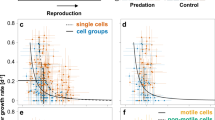Abstract
We examined the evolution of cell groups in ten isogenic lines of the unicellular green alga Chlamydomonas reinhardtii upon exposure to a rotifer predator and found that cell groups evolving in the presence of predation had increased survival compared to single cells but at a cost of reduced reproduction. Identical mutations evolved in cell group isolates and were associated with their growth form. The observation of repeated genomic changes after 500 generations of predator selection, suggest some level of deterministic evolution.
Article PDF
Similar content being viewed by others
Avoid common mistakes on your manuscript.
Literatur
Shelton DE, Michod RE (2014) Group Selection and Group Adaptation During a Major Evolutionary Transition: Insights from the Evolution of Multicellularity in the Volvocine Algae. Biol Theory 9: 452–469
Boraas ME, Seale DB, Boxhorn JE (1998) Phagotrophy by a flagellate selects for colonial prey: A possible origin of multicellularity. Evol Ecol 12: 153–164
Niklas KJ (2014) The evolutionary-developmental origins of multicellularity. Am J Bot 101: 6–25
Sathe S, Durand PM (2016) Cellular aggregation in Chlamydomonas (Chlorophyceae) is chimaeric and depends on traits like cell size and motility. Eur J Phycol 51: 129–138
Becks L, Ellner SP, Jones LE et al. (2010) Reduction of adaptive genetic diversity radically alters eco-evolutionary community dynamics. Ecol Lett 13: 989–997
Michod RE (2006) The group covariance effect and fitness trade-offs during evolutionary transitions in individuality. Proc Natl Acad Sci USA 103: 9113–9117
Bernardes JP, John U, Woltermann N et al. (2021) The evolution of convex trade-offs enables the transition towards multicellularity. Nat Commun 12: 4222
Michod RE, Viossat Y, Solari C.A et al. (2006) Life-history evolution and the origin of multicellularity. J Theor Biol 239: 257–272
Funding
Funding note: Open Access funding enabled and organized by Projekt DEAL.
Author information
Authors and Affiliations
Corresponding authors
Additional information
Lutz Becks 1998–2004 Biologiestudium an der Universität zu Köln und anschließender Promotion an der Universität zu Köln unter Anleitung von Prof. Dr. H. Arndt. 2006–2008 Post-doc an der Cornell University, USA. 2008–2010 Postdoc an der University of Toronto, Kanada. 2010–2011 Postdoc an der Universität zu Köln 2011–2018 Gruppenleiter am Max-Planck-Institut für Evolutionsbiologie (Emmy-Noether Programm und Heisenberg Programm der DFG). Seit 2018 Professor am Limnologischen Institut der Universität Konstanz.
Uwe John 1991–1998 Biologiestudium an der Universität Hannover. 1998–2002 Promotion an der Universität Bremen und unter Anleitung von Prof. Dr. L. Medlin und Prof. Dr. V. Smetacek. 2002–2005 Postdoc von am Alfred-Wegener-Institut Helmholtz Zentrum für Polar- und Meeresforschung (AWI), Bremerhaven. Ab 2005 Leiter der Arbeitsgruppe Öko-Evolutionäre Genomik und Molekular Ökologie am AWI. Seit 2017 Gründungsmitglied des Helmholtz Institutes für Funktionelle Marine Biodiversität (HIFMB).
Rights and permissions
Open Access: Dieser Artikel wird unter der Creative Commons Namensnennung 4.0 International Lizenz veröffentlicht, welche die Nutzung, Vervielfältigung, Bearbeitung, Verbreitung und Wiedergabe in jeglichem Medium und Format erlaubt, sofern Sie den/die ursprünglichen Autor(en) und die Quelle ordnungsgemäß nennen, einen Link zur Creative Commons Lizenz beifügen und angeben, ob Änderungen vorgenommen wurden. Die in diesem Artikel enthaltenen Bilder und sonstiges Drittmaterial unterliegen ebenfalls der genannten Creative Commons Lizenz, sofern sich aus der Abbildungslegende nichts anderes ergibt. Sofern das betreffende Material nicht unter der genannten Creative Commons Lizenz steht und die betreffende Handlung nicht nach gesetzlichen Vorschriften erlaubt ist, ist für die oben aufgeführten Weiterverwendungen des Materials die Einwilligung des jeweiligen Rechteinhabers einzuholen. Weitere Details zur Lizenz entnehmen Sie bitte der Lizenzinformation auf http://creativecommons.org/licenses/by/4.0/deed.de.
About this article
Cite this article
Becks, L., John, U. Genomische Signaturen des Übergangs zur Mehrzelligkeit. Biospektrum 28, 269–271 (2022). https://doi.org/10.1007/s12268-022-1764-z
Published:
Issue Date:
DOI: https://doi.org/10.1007/s12268-022-1764-z




